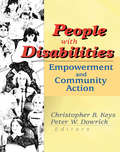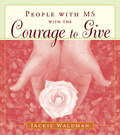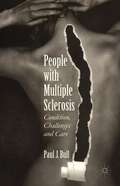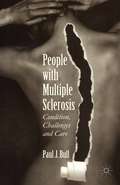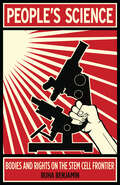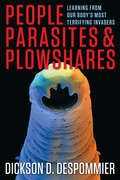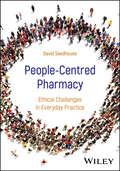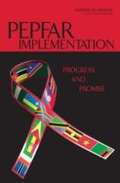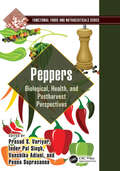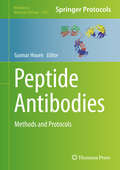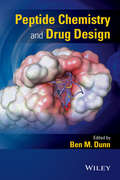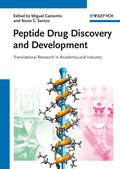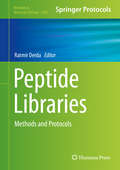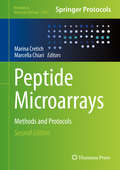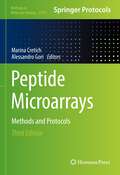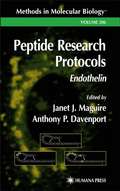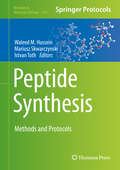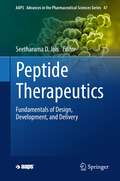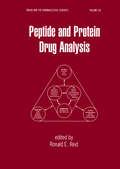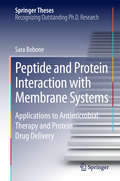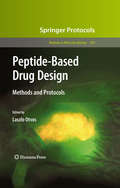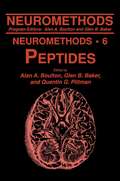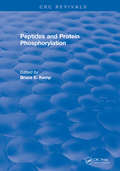- Table View
- List View
People with Disabilities
by Lisa Schur Douglas Kruse Peter Blanck Lisa Schur Douglas KruseTo what extent are people with disabilities fully included in economic, political, and social life? People with disabilities have faced a long history of exclusion, stigma, and discrimination, but have made impressive gains in the past several decades. These gains include the passage of major civil rights legislation and the adoption of the 2006 UN Convention on the Rights of Persons with Disabilities. This book provides an overview of the progress and continuing disparities faced by people with disabilities around the world, reviewing hundreds of studies and presenting new evidence from analysis of surveys and interviews with disability leaders. It shows the connections among economic, political, and social inclusion, and how the experience of disability can vary by gender, race, and ethnicity. It uses a multidisciplinary approach, drawing on theoretical models and research in economics, political science, psychology, disability studies, law, and sociology.
People with Disabilities: Empowerment and Community Action
by Peter W. Dowrick Christopher B. KeysDevelop more effective community initiatives and build solid collaborations!Although the fields of disability studies and community psychology developed separately, with little crossover, they have evolved similar values, principles, and tactics. People with Disabilities: Empowerment and Community Action is the first volume to bring together these two fields. Now disability activists and community psychologists can join forces, share ideas, and gain strength from one another.This landmark volume offers empirical research and practical advice from respected scholars in the field. People with Disabilities: Empowerment and Community Action presents tested strategies for empowering a wide variety of people with disabilities, including Latinos, the aged, the developmentally disabled, low-income schoolchildren, and patients with chronic diseases. The diversity of strategies offered here means that every community can find a way to make its own voice heard.People with Disabilities: Empowerment and Community Action offers detailed, step-by-step plans for developing a broad range of programs, including: choosing strategies to suit rural, suburban, and urban environments taking a capacity-building approach to community empowerment developing participatory action plans building effective coalitions enabling collaboration between inner-city universities and the community With its solid research, helpful tables and figures, and well-organized action plans, this book is certain to become a classic in the fields of disability studies and community psychology.
People with MS with the Courage to Give: (stories Of Successful People With Multiple Sclerosis)
by Jackie WaldmanTwenty-four individuals with multiple sclerosis share their stories—and deliver one inspiring message about overcoming adversity.We don’t get to choose whether or not we have multiple sclerosis, but we do get to decide how we live with it. Author and MS warrior Jackie Waldman delivers a personal message of hope in these twenty-four tales of individuals who did the unthinkable, went against the grain, and proved that an MS diagnosis does not have to box you in.Within these pages, you’ll meet individuals with MS symptoms—but that didn’t stop them from living their best life. You’ll meet Alicia Conill, an M.D. turned founder of The Disability Experience. You’ll also meet Anthony Zaremba, an employee almost fired because of his shaking hands, later recognized for his success in community gardens and Brooklyn wheelchair access. People with MS with the Courage to Give offers:Powerful stories that show how nervous system disorders don’t define youInspirational quotes to boost your self-esteem throughout the dayAdvice from people just like you who encourage you to do the impossible
People with Multiple Sclerosis: Condition, Challenges and Care
by Paul J. BullPeople with Multiple Sclerosis.
People with Multiple Sclerosis: Condition, Challenges and Care
by Paul J. BullMultiple sclerosis is an incurable neurological disease of unknown cause with a fearful reputation for generating disability, unemployment, poverty and early death. This book critically surveys the current state of multiple sclerosis research, demonstrating the shortfall of current research undertaken on the lives of people with multiple sclerosis.
People's Science: Bodies and Rights on the Stem Cell Frontier
by Ruha BenjaminStem cell research has sparked controversy and heated debate since the first human stem cell line was derived in 1998. Too frequently these debates devolve to simple judgments--good or bad, life-saving medicine or bioethical nightmare, symbol of human ingenuity or our fall from grace--ignoring the people affected. With this book, Ruha Benjamin moves the terms of debate to focus on the shifting relationship between science and society, on the people who benefit--or dont--from regenerative medicine and what this says about our democratic commitments to an equitable society. "Peoples Science" uncovers the tension between scientific innovation and social equality, taking the reader inside Californias 2004 stem cell initiative, the first of many state referenda on scientific research, to consider the lives it has affected. Benjamin reveals the promise and peril of public participation in science, illuminating issues of race, disability, gender, and socio-economic class that serve to define certain groups as more or less deserving in their political aims and biomedical hopes. Under the shadow of the free market and in a nation still at odds with universal healthcare, the socially marginalized are often eagerly embraced as test-subjects, yet often are unable to afford new medicines and treatment regimes as patients. Ultimately, Ruha Benjamin argues that without more deliberate consideration about how scientific initiatives can and should reflect a wider array of social concerns, stem cell research-- from African Americans struggle with sickle cell treatment to the recruitment of women as tissue donors--still risks excluding many. Even as regenerative medicine is described as a participatory science for the people, Benjamin asks us to consider if "the people" ultimately reflects our democratic ideals.
People, Parasites, and Plowshares: Learning from Our Body's Most Terrifying Invaders
by Dickson D. DespommierDickson D. Despommier's vivid, visceral account of the biology, behavior, and history of parasites follows the interplay between these fascinating life forms and human society over thousands of years. He focuses on long-term host-parasite associations, which have evolved to avoid or even subvert the human immune system. Some do great damage to their hosts, while others have signed a kind of "peace treaty" in exchange for their long lives within them. They also, Despommier shows as he discusses these organisms with the reader, practice clever survival strategies that doctors hope to mimic as they undertake treatments for Crohns disease, food allergies, type 1 diabetes, organ transplantation, and other as yet unsolved medical challenges. Despommier concentrates on particularly remarkable and often highly pathogenic organisms, describing their life-cycles and the mechanisms they use to avoid elimination. He details their attack and survival plans and the nature of the illnesses they cause in general terms, enabling readers of all backgrounds to steal a glimpse into the secret work of such effective invaders. He also points to the cultural contexts in which these parasites thrive and reviews the current treatments available to defeat them. Encouraging scientists to continue to study these organisms even if their threat is largely contained, Despommier shows how closer dissection of the substances parasites produce to alter our response to them could help unravel some of our most complex medical conundrums.
People, Parasites, and Plowshares: Learning from Our Body's Most Terrifying Invaders
by Dickson DespommierDickson D. Despommier's vivid, visceral account of the biology, behavior, and history of parasites follows the interplay between these fascinating life forms and human society over thousands of years. Despommier focuses on long-term host-parasite associations, which have evolved to avoid or even subvert the human immune system. Some parasites do great damage to their hosts, while others have signed a kind of "peace treaty" in exchange for their long lives within them. Many parasites also practice clever survival strategies that medical scientists hope to mimic as they search for treatments for Crohn's disease, food allergies, type 1 diabetes, organ transplantation, and other medical challenges. Despommier concentrates on particularly remarkable and often highly pathogenic organisms, describing their lifecycles and the mechanisms they use to avoid elimination. He details their attack and survival plans and the nature of the illnesses they cause in general terms, enabling readers of all backgrounds to steal a glimpse into the secret work of such effective invaders. He also points to the cultural contexts in which these parasites thrive and reviews the current treatments available to defeat them. Encouraging scientists to continue to study these organisms even if their threat is largely contained, Despommier shows how closer dissection of the substances parasites produce to alter our response to them could help unravel some of our most complex medical conundrums.
People-Centred Pharmacy: Ethical Challenges in Everyday Practice
by David SeedhouseDiscover people-centred decision-making for pharmacists in this clear and practical volume Pharmacy ethics and decision-making are a critical part of pharmaceutical care. Pharmacists are routinely faced with decisions that impact the immediate and long-term health of patients, and must exercise professional judgement when the best choices are uncertain. Current guides to ethical decision-making in healthcare are generally written for doctors or nurses, overlooking the distinctive needs of pharmacy professionals in this crucial area of practice. People-Centred Pharmacy: Ethical Challenges in Everyday Practice remedies this oversight with a down-to-earth discussion of the common ethical dilemmas pharmacists face. Offering a commonsense focus, the book articulates an approach to practical ethical reasoning that considers the interests of all involved, including the pharmacist. The result is an invaluable resource for pharmacists and those studying the subject. Readers will also find: A text written in collaboration with pharmacy educators Concrete examples drawn from empirical research into pharmacy practice An interdisciplinary approach to the many dilemmas pharmacists face People-Centred Pharmacy: Ethical Challenges in Everyday Practice is ideal for all pharmacy staff, as well as all students of pharmacy.
Pepfar Implementation: Progress And Promise
by Institute of Medicine of the National AcademiesIn 2003 Congress passed the United States Leadership Against HIV/AIDS, Tuberculosis, and Malaria Act, which established a 5-year, $15 billion initiative to help countries around the world respond to their AIDS epidemics. The initiative is generally referred to by the title of the 5-year strategy required by the act--PEPFAR, or the President's Emergency Plan for AIDS Relief. PEPFAR Implementation evaluates this initiative's progress and concludes that although PEPFAR has made a promising start, U.S. leadership is still needed in the effort to respond to the HIV/AIDS pandemic. The book recommends that the program transition from its focus on emergency relief to an emphasis on the long-term strategic planning and capacity building necessary for a sustainable response. PEPFAR Implementation will be of interest to policy makers, health care professionals, special interest groups, and others interested in global AIDS relief.
Peppers: Biological, Health, and Postharvest Perspectives (Functional Foods and Nutraceuticals)
by Penna Suprasanna Prasad S. Variyar Vanshika Adiani Inder Pal SinghThere is an increased awareness on the relevance of nutraceutical and functional foods as alternatives to harmful synthetic additives used in industry. Different peppers, with an abundance of bioactive compounds, are highlighted in this book, which provides a comprehensive evaluaton of their importance as nutraceutical and functional foods to all stakeholders in the agri-food and pharmaceutical industries. Peppers: Biological, Health, and Postharvest Perspectives is a valuable addition to the existing information resource on peppers.Key features: Highlights the advancements made in biodiversity, biochemistry and biosynthesis of bioactive compounds of peppers. Reviews the effects of processing methods on the quality of peppers to facilitate further research and development of foods having pepper as an essential nutritional component. Provides help in selecting better processing methods for the management of nutritional attributes and health benefits of peppers. The book provides a blend of basic and advanced information for postgraduate students, researchers and scientists
Peptide Antibodies
by Gunnar HouenThis extensive volume covers basic and advanced aspects of peptide antibody production, characterization and uses. Although peptide antibodies have been available for many years, they continue to be a field of active research and method development. For example, peptide antibodies which are dependent on specific posttranslational modifications are of great interest, such as phosphorylation, citrullination and others, while different forms of recombinant peptide antibodies are gaining interest, notably nanobodies, single chain antibodies, TCR-like antibodies, among others. Within this volume, those areas are covered, as well as several technical and scientific advances: solid phase peptide synthesis, peptide carrier conjugation and immunization, genomics, transcriptomics, proteomics and elucidation of the molecular basis of antigen presentation and recognition by dendritic cells, macrophages, B cells and T cells. Written in the highly successful Methods in Molecular Biology series format, chapters include introductions to their respective topics, lists of the necessary materials and reagents, step-by-step, readily reproducible laboratory protocols and tips on troubleshooting and avoiding known pitfalls. Comprehensive and authoritative, Peptide Antibodies: Methods and Protocols serves as an ideal reference for researchers exploring this vital and expansive area of study.
Peptide Chemistry and Drug Design
by Ben M. DunnThis book focuses on peptides as drugs, a growing area of pharmaceutical research and development. It helps readers solve problems of discovering, developing, producing, and delivering peptide-based drugs. * Identifies promising new areas in peptide drug discovery * Includes chapters on discovery from natural sources, metabolic modification, and drug delivery * Overviews separation methods and techniques for analysis, bond formation, and purification * Offers readers both a professional reference and a text or resource for graduate-level students
Peptide Drug Discovery and Development: Translational Research in Academia and Industry
by Nuno C. Santos CastanhoFilling a real knowledge gap, this handbook and ready reference is both modern and forward-looking in its emphasis on the "bench to bedside" translational approach to drug development. Clearly structured into three major parts, the book stakes out the boundaries of peptide drug development in the preclinical as well as clinical stages. The first part provides a general background and focuses on the characteristic strengths and weaknesses of peptide drugs. The second section contains five cases studies of peptides from diverse therapeutic fields, and the lessons to be learned from them, while the final part looks at new targets and opportunities, discussing several drug targets and diseases for which peptide drugs are currently being developed.
Peptide Libraries
by Ratmir DerdaThis volume provides an overview of modern and emerging methods for production, analysis, and utility of peptide libraries. Chapter focus on methods and techniques for synthesis, genetic expression, hybrid synthesis-expression, examples of modern utility of these libraries, de novo discovery of reactions, hybrid organic-inorganic materials and, emerging tools for the analysis of these libraries by method of genetic selection and next-generation sequencing. Written in the highly successful Methods in Molecular Biology series format, chapters include introductions to their respective topics, lists of the necessary materials and reagents, step-by-step, readily reproducible laboratory protocols, and tips on troubleshooting and avoiding known pitfalls. Authoritative and practical, Peptide Libraries: Methods and Protocols seeks to serve both professionals and novices with its well-honed methodologies.
Peptide Microarrays
by Marina Cretich Marcella ChiariDue to their versatility, along with the diminishing costs of library synthesis and the growth of commercial support, peptide microarrays will likely expand beyond being just a research tool into an adaptable and powerful platform to be harnessed for wider drug discovery and point-of-care applications. In Peptide Microarrays: Methods and Protocols, experts in the field provide a cutting-edge view of peptide array technology, its applications, and technical issues. After examining how peptides can characterize proteins and clarify, at the amino acid level, the molecular recognition events in which they are involved, the volume goes on to cover topics such as the production and use of peptide arrays for enzyme and binding motifs characterization, epitope mapping, and diagnostics, the newest technological advancements, as well as software and web tools for the design of peptide arrays and for the analysis of output data. As a volume in the highly successful Methods in Molecular BiologyTM series, chapters include brief introductions to their respective topics, lists of the necessary materials and reagents, step-by-step, readily reproducible laboratory protocols, and notes on troubleshooting and avoiding known pitfalls. Authoritative and easy-to-use, Peptide Microarrays: Methods and Protocols promises to serve scientists with its unique insights and novel solutions in peptide array technology in order to advance this vital field.
Peptide Microarrays: Methods and Protocols (Methods in Molecular Biology #2578)
by Marina Cretich Alessandro GoriThis detailed volume provides an updated overview of current uses of peptide microarray technology, showcasing consolidated applications while highlighting some of the most intriguing novelties and emerging fields of use. The methodologies within this collection are of considerable value for both advanced users and new-comers in the peptide microarray arena, as the renowned contributors describe full coverage of the aspects related to their workflows, from microchip manufacturing to advanced analytical applications. Written for the highly successful Methods in Molecular Biology series, chapters include introductions to their respective topics, lists of the necessary materials and reagents, step-by-step and readily reproducible laboratory protocols, and tips on troubleshooting and avoiding known pitfalls. Authoritative and up-to-date, Peptide Microarrays: Methods and Protocols, Third Edition aims to make the use of peptide microarrays more and more accessible while stimulating further developments to sustain exciting discoveries in the biochemistry and medicine realms.
Peptide Research Protocols
by Anthony P. Davenport Janet J. MaguireA panel of multidisciplinary experts describes in detail readily reproducible methods to investigate all aspects of the endothelin system from its synthesis and metabolism, to its function in health and disease. Theses methods use state-of-the-art molecular techniques to quantify the expression of mRNA for both endothelin receptors and the endothelin converting enzymes. They show how peptides, precursors, receptors, and synthetic enzymes can be localized and quantified in plasma, culture supernatants, tissue homogenate, and tissue sections using antibodies. Several in vivo protocols illustrate the role of the endothelin peptides in healthy human individuals and describe animal models that can be used to predict the therapeutic potential of cardiovascular drugs that manipulate endothelin synthesis or function.
Peptide Synthesis: Methods and Protocols (Methods in Molecular Biology #2103)
by Waleed M. Hussein Mariusz Skwarczynski Istvan TothThis book provides a variety of procedures for synthetically producing peptides and their derivatives, ensuring the kind of precision that is of paramount importance for successful synthesis. Numerous techniques relevant to drugs and vaccines are explored, such as conjugation and condensation methodologies. Written for the highly successful Methods in Molecular Biology series, chapters include introductions to their respective topics, lists of the necessary materials and reagents, step-by-step, readily reproducible laboratory protocols, and tips on troubleshooting and avoiding known pitfalls. Authoritative and practical, Peptide Synthesis: Methods and Protocols serves as an essential guide to the many crucial processes that will allow researchers to efficiently prepare, purify, characterize, and use peptides for chemical, biochemical, and biological studies.
Peptide Therapeutics: Fundamentals of Design, Development, and Delivery (AAPS Advances in the Pharmaceutical Sciences Series #47)
by Seetharama D. JoisThis book explains how peptide-based drug design works, what steps are needed to develop a peptide-based therapeutic, and challenges in synthesis as well as regulatory issues. It covers the design concept of peptide therapeutics from fundamental principles using structural biology and computational approaches. The chapters are arranged in a linear fashion. A fresh graduate or a scientist who works on small molecules can use this to follow the design and development of peptide therapeutics to use as understanding the basic concepts. Each chapter is written by experts from academia as well as industry. Rather than covering extensive literature, the book provides concepts of design, synthesis, delivery, as well as regulatory affairs and manufacturing of peptides in a systematic way with examples in each case. The book can be used as a reference for a pharmaceutical or biomedical scientist or graduate student who wants to pursue their career in peptide therapeutics. Some chapters will be written as a combination of basic principles and protocol so that scientists can adopt these methods to their research work. The examples provided can be used to perform peptide formulation considerations for the designed peptides. The book has nine chapters, and each chapter can be read as an independent unit on a particular concept.
Peptide and Protein Drug Analysis
by Paul C. H. LiFurthering efforts to simulate the potency and specificity exhibited by peptides and proteins in healthy cells, this remarkable reference supplies pharmaceutical scientists with a wealth of techniques for tapping the enormous therapeutic potential of these molecules-providing a solid basis of knowledge for new drug design.Provides a broad, comp
Peptide and Protein Interaction with Membrane Systems
by Sara BoboneIn her thesis, Sara Bobone outlines spectroscopic studies of antimicrobial peptides (AMPs) which are promising lead compounds for drugs used to fight multidrug resistant bacteria. Bobone shows that AMPs interact with liposomes and she clarifies the structure of pores formed by one of these molecules. These results help us to understand how AMPs are selective for bacterial membranes and how their activity can be finely tuned by modifying their sequence. Findings which solve several conundrums debated in the literature for years. In addition, Bobone uses liposomes as nanotemplates for the photopolymerization of hydrogels - exploiting the self- assembly properties of phospholipids. Bobone was able to trap an enzyme using nanometeric particles, while still allowing its activity by the diffusion of substrates and products through the network of the polymer. The innovative nano devices described in this thesis could solve many of the hurdles still hampering the therapeutic application of protein-based drugs.
Peptide-Based Drug Design
by Laszlo OtvosDue to their high specificity and low toxicity profile, peptides have once again become central to the development of new drugs. In Peptide-Based Drug Design: Methods and Protocols, expert researchers provide a handbook which offers a selection of research and production tools suitable for transforming a promising protein fragment or stand-alone native peptide into a pharmaceutically acceptable composition. The volume delves into contemporary, cutting-edge subjects such as hit isolation and target validation, computer-aided design, sequence modifications to satisfy pharmacologists, in vivo stability and imaging, and the actual production of difficult sequences. Written in the highly successful Methods in Molecular BiologyTM series format, chapters include readily reproducible, step-by-step laboratory protocols, lists of materials, and the Notes section, which highlights tips on troubleshooting and avoiding known pitfalls. Comprehensive and up-to-date, Peptide-Based Drug Design: Methods and Protocols shows its subject to be an independent science on the rise, and provides scientists with a clear, concise guide for continuing this vital research.
Peptides (Neuromethods #6)
by Alan A. Boulton Glen B. Baker Q. J. PittmanThis timely new volume in Bouton and Bader's highly practical Neuromethods series presents state-of-the-art techniques for neuropeptide research. Neuromethods * 6 * Peptides highlights the vast array of novel techniques that are essential for identifying neural peptides and explaining their roles, which have become a significant focus of attention in neuropharmacology today. In addition to providing a detailed methodological formula for each technique, the authors - all renowned experts in their particular areas - also demonstrate how their powerful new methodologies contribute to our understanding of neuropeptide function. Chapters explore: * posttranslational processing, * radioimmunoassay development, * in vitro peptide release, * peptide analogs, * molluscan models, * anitbody production, * immunohistochemical localization, * peptide release in vivo, * postsynaptic sequences, * electrophysiological techniques
Peptides and Protein Phosphorylation
by B.E. KempThis comprehensive volume focuses on the ways in which synthetic peptides have been exploited in order to expand our understanding of the molecular mechanisms involved in protein phosphorylation. It recognizes that virtually all physiological processes are regulated by protein phosphorylation. It discusses the use of synthetic peptides in studying the catalytic mechanism and regulation of protein kinases. It also includes the chemical synthesis of phosphorylated peptides and preparation of specific antisera. This incredible work has lead to the development of a new generation of peptide inhibitors with potencies of greater magnitude than those previously known. Everyone involved with biochemistry and molecular biology will find this one-of-a-kind resource fascinating and filled with useful information.

